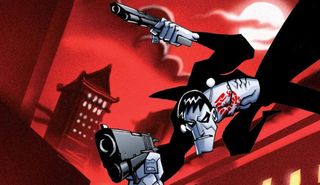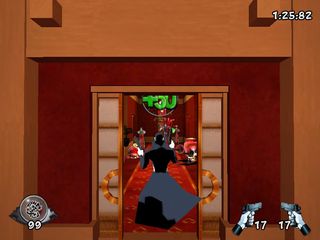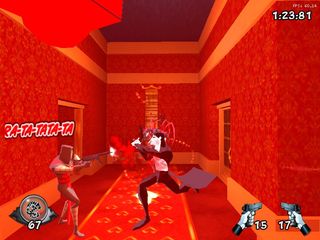One of the worst games of all time is now on Steam: Revisiting Drake of the 99 Dragons
Does Drake live up to its reputation as a horrible game? And why did it get released on Steam in 2018?

Someone probably knows how Drake of the 99 Dragons ended up on Steam, but I can't find them. Majesco, the game's embattled publisher, has dutifully emptied their back catalog onto the service over the past few years, ostensibly with the hope that cult classics like Advent Rising and A Boy and His Blob might summon up a brief renaissance, or at least help them find some quarters in the cushions. Still, this is a weird choice. As a teenaged disciple of the games media, Drake of the 99 Dragons was the first game I remember earning a gleeful shellacking from all sides. Gamespot saddled it with a 1.6, IGN with a 2.9, and Electronic Gaming Monthly, who in those days assigned three critics each to every review, gave it a 2.5, a 2, and a 0.5, earning it the Shame of the Month.
Drake intends to be a stylish, soapy corridor shooter starring a trenchcoat-draped assassin branded with a Slipknot-tier magical skull tattoo on his pallid chest.
Those abysmal scores earned Drake of the 99 Dragons an ignoble reputation, but as a whole, I don't know if it quite stacks up to the comical reverence pressed upon the really bad games. You know what I'm talking about: Big Rigs, E.T., even the relatively recent Ride To Hell: Retribution, with its once-in-a-lifetime fully clothed sex scenes. Drake was plenty turgid and stupid, sure, but it didn't fail in spectacular enough fashion to canonize its legend. Instead, it was left to rot in the forbidden corners of Majesco's coffers. That is, until now.
I spent $4.95 for the privilege of playing Drake of the 99 Dragons in 2018. From what I understand, the version on Steam is a mirror image of the PC copy that was originally released back in 2004. It has all the trappings of a cast-off PC port: the tutorial asks me to press the "fire" button, I guess because they couldn't be bothered to write in the keystroke replacement.

Drake intends to be a stylish, soapy corridor shooter starring a trenchcoat-draped assassin branded with a Slipknot-tier magical skull tattoo on his pallid chest, in a cartoonishly gothic Hong Kong. Drake, a white guy, is placed at the apex of this triad saga, which is a questionable choice that the games media of the time didn't address. The plot centers around a life-giving artifact that's been pilfered from the proud 99 Dragons clan. Our only recourse is to run through an endless series of ugly cel-shaded hovels with two pistols and a scowl.
Functionally, the game feels like a drunk Max Payne. Developer Idol FX was clearly seduced by some of the impressive innovations in third-person game design in the early 2000s, so they saddle Drake with double-jumps, wall-runs, and a bullet-time meter. Unfortunately, all of those features have the polish of a ROM hack.
The wall-runs are especially hilarious. They have such an unpleasant sensation that you literally feel like you're breaking the game. Ideally you're supposed to combine all those acrobatics into awesome, John Woo-style kills, but the aiming is so imprecise and alien that the only effective strategy I found was to slow down time and methodically dispatch the enemies in my way one by one. So yes, I suppose it is kind of like Max Payne, if Max Payne was addicted to cough syrup.
What's funny is that apparently this PC port is somehow the best version of Drake of the 99 Dragons. If you page through those old console reviews, every critic bemoans an auto-aim functionality that was either finecky or straight-up broken, depending on who you talk to. "The gimmick was Drake could dual-wield guns, and as part of that aim in basically any direction," says Alex Navarro from Giant Bomb, who reviewed the game back in his Gamespot years. "But the auto-targeting would frequently go searching for enemies that weren't visible, which meant his arms were constantly flailing and half the bad guys in front of you wouldn't be properly targeted."
The biggest gaming news, reviews and hardware deals
Keep up to date with the most important stories and the best deals, as picked by the PC Gamer team.

On PC, that auto-targeting is missing. I suspect the reasons for this are twofold: Majesco probably trusted the precision of a mouse and keyboard more than the analog sticks of the PS2 era, but given that Drake was released on computers a year after its debut on consoles, I imagine the company decided to cut their losses by excising the auto-aim altogether, in a faint hope that they might be able to save face. This is still a bad game on PC, but it's not as aggressively misconceived.
"In retrospect, it does feel like maybe we've lost something. Not something good, but something that felt like it should be there regardless."
Alex Navarro
Honestly, bad as it is, I kinda enjoyed my brief time with Drake of the 99 Dragons. As a professional I can't recommend anyone purchase it, but as a child who grew up with an Xbox, and played a ton of mediocre trash served up in Blockbuster rental sections, I found that it made me strangely wistful. A huge part of this industry was once defined by budget games put together by small teams with limited resources; a time when not everything had to come with a bolted-on multiplayer mode, an always-online mandate, and a five-year plan for post-launch monetization. No, instead you could go make Voodoo Vince, or Blinx: The Time Sweeper, or Blood Wake.
Those games were all equally unremarkable in 2003. In 2018, the idea of a publisher pressing a disc with a voodoo doll mascot platformer seems close to impossible (although Vince did get a PC remaster just last year). I suppose there's something gratifying about the fact that Drake was once allowed to self-immolate in public.
"I don't know if it's better or worse that non-indie games mostly only exist as either incredibly high-budget triple-A experiences or mobile slot machines, with no middle ground in-between for mediocre genre trash. I'm generalizing of course, but it does feel like the whole midsection of gaming got sucked out sometime in the not-too-distant past, and the bottom rung largely became the domain of random garbage hucksters on Steam. A lot of that old stuff was major trash, but there was also something sort of comforting in the knowledge that those middle and budget (bad) tiers could even exist within a publisher's catalog," says Navarro. "Not so much at the time, because when you're reviewing McFarlane's Evil Prophecy and Robocop and Drake of the 99 Dragons, all you want is for developers to immediately stop making games like that. But in retrospect, it does feel like maybe we've lost something. Not something good, but something that felt like it should be there regardless."
Majesco, of course, has been swallowed up whole by the new financial realities of the games industry. In 2016, the Biotech firm PolarityTE merged with (and wrested control) of the company's holdings, and ordered them to suspend their video game operations indefinitely. Majesco still exists as a nuclear shadow—someone is still running the Twitter account, and someone is obviously going to the tape library to put those old games on the Steam marketplace—but it's clear that they only have a past, not a future, in this business.
In that sense, I'll take the resurrection of Drake of the 99 Dragons to be a triumph. It's made at least one person genuinely happy: the writer of the Bad Game Hall of Fame blog, Drake's self-professed biggest fan, reacted to the news with an article that begins "Dreams really do come true." Majesco is dead, but they're still calcifying their legacy. Let that be an inspiration to us all. If some venture capitalist vampires run you out of business, respond by uploading one of the most maligned games of all time to Steam, and ask for $5 a pop. Solidarity, Drake. Solidarity.

Luke Winkie is a freelance journalist and contributor to many publications, including PC Gamer, The New York Times, Gawker, Slate, and Mel Magazine. In between bouts of writing about Hearthstone, World of Warcraft and Twitch culture here on PC Gamer, Luke also publishes the newsletter On Posting. As a self-described "chronic poster," Luke has "spent hours deep-scrolling through surreptitious Likes tabs to uncover the root of intra-publication beef and broken down quote-tweet animosity like it’s Super Bowl tape." When he graduated from journalism school, he had no idea how bad it was going to get.
Most Popular


